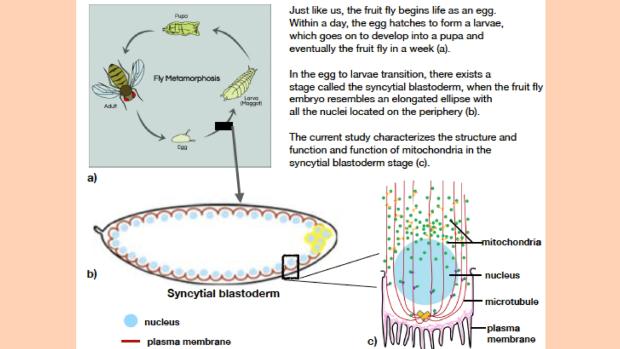
Illustration : Sayali Chowdhary and Richa Rikhy
Over a trillion cells work round the clock with remarkable accuracy and precision to keep us healthy and happy. How do these cells – our building blocks, get energy to work 24*7? Within the cells reside numerous tiny, rod-shaped compartments – the mitochondria, also called the powerhouse of the cell. They are responsible for producing energy for all the tasks that cells perform. Besides being the energy centre, the mitochondria also actively participate in cell division and cell signalling. The dynamics of mitochondrial function in the cell is an area of active research.
A recent study published in Scientific Reports by Prof. Richa Rikhy’s lab at the Indian Institute of Science Education and Research (IISER) - Pune explores the organization and function of mitochondria in the context of early embryonic development.
Mammalian embryonic development is long and occurs inside the mother’s uterus, which makes it technically very challenging to study. Biologists thus turn to simple organisms like the fruit fly, Drosophila melanogaster, which develops from an egg to a larva in short time -1 day and ex-utero or outside the mother. Like mammalian embryos, mitochondria in Drosophila are inherited in embryos from the mother. The first phase of Drosophila development comprises rapid divisions, where the nucleus of the egg divides again and again, to form 6000 nuclei by the end of 13 such division cycles. All the 6000 nuclei are present at the periphery of the ellipse shaped fruit fly embryo, the inside being filled with yolk. This particular stage of fruit fly development, with one cytoplasm engulfing multiple nuclei, is called the syncytial blastoderm. The region surrounding one nucleus is called a syncytial cell. The current study specifically examines mitochondrial function in the syncytial blastoderm stage of fruit fly embryonic development.
To begin with, Prof. Rikhy’s team characterized the physical features, quantity and location of mitochondria in the syncytial blastoderm. For this, they labelled the mitochondria with a fluorescent protein. This enabled them to see the mitochondria using high-resolution microscopy. The team found that several round and tiny mitochondria were concentrated near the nucleus of the syncytial cell. Moreover, the mitochondria were not static, but moving around in the cell. But how do they move? Inside a cell, lies an extensive network of fibrous proteins called the cytoskeleton that gives the cell its form and structure. The team found that mitochondria hitchhike on microtubules, a component of cytoskeleton network. And being small facilitates their hitchhiking.
One of the primary functions of the mitochondria is energy generation. However, previous studies have shown that small mitochondria are not so efficient at generating energy. Are the small mitochondria in fruit fly’s blastoderm generating energy? To answer this question, the team inhibited the function of these mitochondria. This activated an energy sensor alarm in the cell and also perturbed the regular cell division process. Thus, the small mitochondria in the fruit fly are generating energy that is essential for the proper cell division.
As the syncytial blastoderm grows further, the major body axis of the fly are specified. Are the small mitochondria important for this stage of development? In the future, Prof. Rikhy’s team might have an answer. Talking about the next steps, Prof. Rikhy highlights, “We hope to determine the myriad ways in which mitochondria contributes to subsequent developmental processes such as formation of body axis.”






